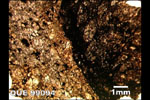
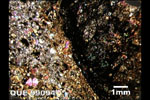
| Sample No.: | QUE 99094 |
| Location: | Queen Alexandra Range |
| Field No.: | 11495 |
| Dimensions (cm): | 6.0x5.5x4.0 |
| Weight (g): | 329.3 |
| Meteorite Type: | H5 Chondrite |
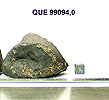
Macroscopic Description: Kathleen McBride
85% of the meteorite's surface is covered with a smooth, brown-black fusion crust. The crust displays polygonal fractures and oxidation halos. The interior reveals a gray matrix with small gray chondrules and larger medium gray clasts, one measuring 2x3 cm in size. The interior is moderately rusty with a high metal content.
Thin Section (,2) Description: Linda Welzenbach and Tim McCoy

|

|
| Plane-Polarized Light | Cross-Polarized Light |
| Sample No.: | QUE 99113 |
| Location: | Queen Alexandra Range |
| Field No.: | 12111 |
| Dimensions (cm): | 1.5x1.0x0.5 |
| Weight (g): | 0.576 |
| Meteorite Type: | CM2 Chondrite |
Macroscopic Description: Kathleen McBride
Dull, black fusion crust covers 20% of the exterior of this carbonaceous chondrite. The interior is a dark gray to black matrix with millimeter sized white and light gray inclusions.
Thin Section (,3) Description: Tim McCoy and Linda Welzenbach
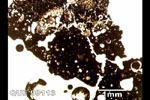 The section measures 8x5 mm. Vesicular fusion crust comprises ~80% of the section. Unaltered material is relatively rare. A few large chondrules are present at one end, although no unaltered matrix may remain. Olivine compositions are Fa3-13, with most less than Fa4, and orthopyroxene is Fs2-13. The meteorite is a CM2 chondrite. It is possible that it is spalled off of a larger mass in flight, explaining the abundance of fusion crust.
The section measures 8x5 mm. Vesicular fusion crust comprises ~80% of the section. Unaltered material is relatively rare. A few large chondrules are present at one end, although no unaltered matrix may remain. Olivine compositions are Fa3-13, with most less than Fa4, and orthopyroxene is Fs2-13. The meteorite is a CM2 chondrite. It is possible that it is spalled off of a larger mass in flight, explaining the abundance of fusion crust.
| Sample No.: | QUE 99122; 99157; 99158 |
| Location: | Queen Alexandra Range |
| Field No.: | 11613; 11600; 11641 |
| Dimensions (cm): | 3.0x2.0x1.5; 3.0x1.25x1.5; 4.0x2.5x2.0 |
| Weight (g): | 19.936; 10.67; 31.012 |
| Meteorite Type: | Enstatite Meteorite Ungrouped |

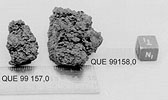
Macroscopic Description: Kathleen McBride
10% of the exterior of these meteorites are covered with patchy brown-black fusion crust. The interiors reveal rusty crystalline material that crumbles easily. These meteorites are too rusty to observe any visible inclusions.
Thin Section (,2) Descriptions: Tim McCoy and Linda Welzenbach
These meteorites are so similar that a single description suffices. The section consists of mm-sized enstatite grains (Fs0-1), SiO2, zoned plagioclase (An7-31), potassium feldspar, metal, troilite, daubreelite, alabandite and schreibersite. The latter phases often occur as rounded enclaves in the enstatite. These meteorites are paired with the QUE 99059/94204/97348/97289 grouping. Unlike these earlier members, which contained either plagioclase or SiO2, these three contain both phases. These meteorites are unusual aubrites or enstatite chondrite impact melt rocks.

|
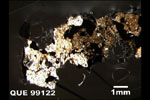
|
|
| QUE 99122 Plane-Pol. Light | QUE 99122 Cross-Pol. Light |
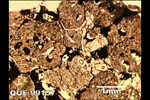
|

|

|
| QUE 99157 Plane-Pol. Light | QUE 99157 Cross-Pol. Light | QUE 99157 Cross-Pol. Light |

|
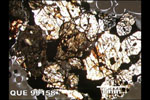
|
|
| QUE 99158 Plane-Pol. Light | QUE 99158 Cross-Pol. Light |
| Sample No.: | QUE 99134 |
| Location: | Queen Alexandra Range |
| Field No.: | 11656 |
| Dimensions (cm): | 0.5x0.5x.25 |
| Weight (g): | 0.387 |
| Meteorite Type: | Metal |
Macroscopic Description: Kathleen McBride
The exterior is vesicular and covered completely with brown/black fusion crust. The interior has a high metal content with some white granular minerals and some black "spongy" material.
Thin Section (,5) Description: Tim McCoy, Linda Welzenbach and Gretchen Benedix
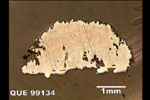
|
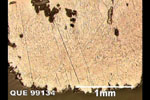
|
| Reflected Light | Reflected Light |
| Sample No.: | QUE 99145 |
| Location: | Queen Alexandra Range |
| Field No.: | 11458 |
| Dimensions (cm): | 1.5x1.0x0.75 |
| Weight (g): | 2.034 |
| Meteorite Type: | L5 Chondrite |
Thin Section (,2) Description: Linda Welzenbach and Tim McCoy
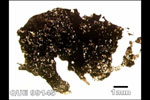
|
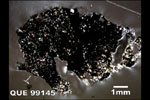
|
| Plane-Polarized Light | Cross-Polarized Light |
| Sample No.: | QUE 99177 |
| Location: | Queen Alexandra Range |
| Field No.: | 11631 |
| Dimensions (cm): | 4.0x3.0x2.0 |
| Weight (g): | 43.555 |
| Meteorite Type: | CR2 Chondrite |
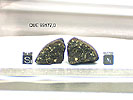
Macroscopic Description: Kathleen McBride
The exterior is completely covered with weathered brown-black fusion crust exhibiting polygonal fractures and evaporites. The interior is a chocolate brown, soft matrix with rust and cream colored chondrules ranging in size from 1 to 3 mm.
Thin Section (,4) Description: Tim McCoy and Linda Welzenbach
The section exhibits well-defined, metal-rich chondrules up to 2 mm in diameter in a dark matrix of FeO-rich phyllosilicate and metal. Polysynthetically twinned pyroxene is abundant. Silicates are unequilibrated; olivines range from Fa1-31, with most Fa0-2, and pyroxenes from Fs1-7Wo1-5. The meteorite is probably a CR2 chondrite.
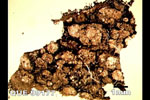
|
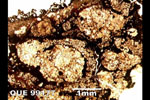
|
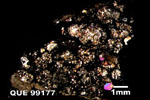
|

|
| Plane-Polarized Light | Plane-Polarized Light | Cross-Polarized Light | Cross-Polarized Light |
| Sample No.: | QUE 99231 |
| Location: | Queen Alexandra Range |
| Field No.: | 11649 |
| Dimensions (cm): | 1.5x1.0x0.75 |
| Weight (g): | 1.497 |
| Meteorite Type: | Diogenite |

Macroscopic Description: Kathleen McBride
25% of the exterior surface is covered with thin, black shiny fusion crust. This achondrite's interior has an off-white, opaque crystalline matrix with ~ 1 mm size black and green minerals.
Thin Section (,3) Description: Tim McCoy and Linda Welzenbach
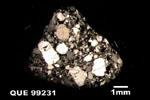
|
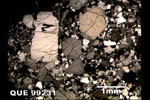
|
| Cross-Polarized Light | Cross-Polarized Light |
| Sample No.: | QUE 99309 |
| Location: | Queen Alexandra Range |
| Field No.: | 12177 |
| Dimensions (cm): | 1.0x0.75x0.5 |
| Weight (g): | 1.747 |
| Meteorite Type: | CB Chondrite (Reclassifed 7/2003 from Chondrite Ungrouped to Metal-Rich Chondrite. Reclassified to CB Chondrite 8/2006) |
Macroscopic Description: Kathleen McBride
100% of the exterior is covered with brown/black fusion crust. The interior is rusty brown and moderately hard.
Thin Section (,2) Description: Tim McCoy and Linda Welzenbach

|

|
| Reflected Light | Reflected Light |
| Sample No.: | QUE 99799 |
| Location: | Queen Alexandra Range |
| Field No.: | 12184 |
| Dimensions (cm): | 2.5x2.0x1.25 |
| Weight (g): | 8.298 |
| Meteorite Type: | Eucrite (Brecciated) |
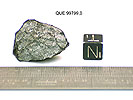
Macroscopic Description: Kathleen McBride
Approximately 40% of this achondrite's exterior has a shiny black fusion crust with some dull and weathered patches. The interior is white matrix with long, thin black minerals. The meteorite looks shocked. A broken, weathered face has small, black globs that resemble fusion crust.
Thin Section (,2) Description: Tim McCoy and Linda Welzenbach
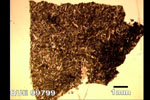
|
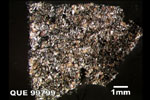
|
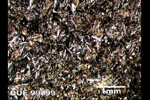
|
| Plane-Polarized Light | Cross-Polarized Light | Cross-Polarized Light |
| Sample No.: | BTN 00300 |
| Location: | Bates Nunataks |
| Field No.: | 12056 |
| Dimensions (cm): | 5.0x3.5x4.0 |
| Weight (g): | 124.563 |
| Meteorite Type: | Eucrite |
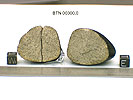
Macroscopic Description: Kathleen McBride
The exterior is 100% fully covered with fusion crust. It has no chips or cracks and looks as though it fell to earth yesterday. The fusion crust is black, glassy and has a ropy texture. The interior has a sandy texture, tan in color giving the appearance similar to sandstone. Binocular microscope shows dense, fine-grained clear yellow (citrine colored) and root beer colored crystals. There are some black mineral grains as well. This meteorite was much more dense and difficult to break than most other similar looking stones.
Thin Section (,2) Description: Tim McCoy and Linda Welzenbach
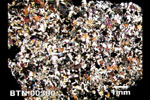
|
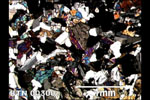
|
| Cross-Polarized Light | Cross-Polarized Light |
| Sample No.: | DRP 00200; 00201 |
| Location: | Derrick Peak |
| Field No.: | 12000; 12299 |
| Dimensions (cm): | 24.0x10.0x12.5; 14.0x10.0x8.0 |
| Weight (g): | 10,000.0; 2689.4 |
| Meteorite Type: | Iron-IIAB |
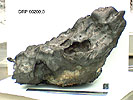
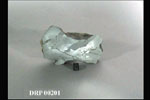
Macroscopic Description: Tim McCoy
These two masses each exhibit a highly corroded and discolored surface, where they were in contact with the soil on Derrick Peak, and a shiny brown surface. The upper surface is highly pitted. The larger of the two masses exhibits prominent linear protrusions of resistant schreibersite crystals in depressions formed by severe terrestrial weathering and removal of the original surface. These depressions are aligned, probably reflecting alignment of the resistant schreibersite.
Microscopic Description: Tim McCoy
On a cut surface, these are typical members of the Derrick Peak iron shower (Clarke, Meteoritics 17, 129). Only a thin layer of corrosion is found on the surface and neither fusion crust nor heat-altered zone is found. Structurally, they are coarsest octahedrites with large areas of swathing kamacite enclosing elongate, skeletal schreibersite crystals and cm-sized round troilite inclusions. Like other Derrick Peak irons, they are certainly members of group IIAB.
| Sample No.: | MET 00400; 00401; 00402; 00403; 00404; 00405; 00406; 00407; 00408; 00409; 00410; 00411; 00412; 00413; 00414; 00415; 00416; 00417; 00418; 00419; 00420; 00421; 00859 |
| Location: | Meteorite Hills |
| Field No.: | 12293; 13464; 13465; 13132; 13449; 12214; 12352; 12229; 13492; 1263; 12297; 12273; 13788; 12285; 12277; 12271; 13340; 12260; 12237; 12221; 12256; 12098 |
| Dimensions (cm): | 17.5x11.0x7.0; 6.0x4.5x3.0; 4.5x3.0x3.0; 5.0x2.5x1.5; 3.0x1.5x1.0; 2.5x1.5x1.0; 2.5x1.5x1.0; 1.5x1.5x1.0; 4.0x2.0x0.75; 3.0x1.5x1.0; 1.5x1.0x0.75; 1.5x1.0x0.75; 2.5x0.75x1.5; 1.0x1.0x1.0; 1.5x1.0x1.0; 2.0x1.5x0.75; 2.0x1.0x0.75; 2.0x1.0x0.75; 2.0x1.5x1.0; 2.5x1.0x0.75; 2.5x1.25x0.75; 2.5x1.5x0.5; 3.0x2.5x1.5 |
| Weight (g): | 4583.8; 205.124; 82.595; 58.533; 20.675; 17.048; 16.128; 5.421; 18.088; 14.023; 2.973; 3.231; 8.664; 3.801; 4.84; 5.228; 4.374; 7.757; 4.841; 9.041; 6.298; 6.707; 33.85 |
| Meteorite Type: | Iron-IIIAB |
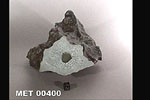
|

|

|
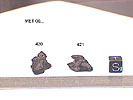
|

|
Circumstances of Find (John Schutt, Tim McCoy)
These 23 meteorites range in mass from 4583.8 to 3.2 grams. They occurred within 200 m on either side of a line 5.8 km long connecting the largest and smallest mass. Although larger masses tend to lie at one end and smaller masses at the other, the distribution is imperfect and a mixed-mass clump is found in the center. The lineation of the distribution is not a result of either ice exposure or search strategy, as a much larger, rectangular area of blue ice was exposed and searched and meteorites were recovered throughout this larger area. The lineation may suggest a relatively recent fall.
Macroscopic Description: Tim McCoy
MET 00400, the largest of the masses at 4583.8 g, has an upper regmaglypt-covered surface with a shiny brown coating. A prominent peak is formed by the intersection of several regmaglypts. The lower surface appears to be an earlier generation of fusion crust, with much shallower and larger depressions and a brown, matte finish. The other masses, ranging from 3.2 to 205.1 grams, are irregularly shaped with a shiny brown fusion crust similar to the upper surface of MET 00400. Smaller regmaglypts and depressions are common. Rare knobby surfaces are likely weathered fusion crust. Macroscopic similarities strongly support the pairing of these 23 meteorites. Slices were removed from MET 00400 (4583.8 g), 00401 (205.1g), 00402 (82.6 g), 00403 (58.5 g) and 00412 (8.7g) for examination. These masses were chosen to sample the ranges of masses and locations within the distribution. MET 00400 and 00412 are separated by 5.3 km.
Microscopic Description: Tim McCoy
All 5 meteorites are essentially identical (further supporting a pairing for all 23 meteorites) and a single description will suffice. The surfaces are dominantly covered by corrosion products up to ~200 microns in thickness. Corrosion does not penetrate into the interiors of these masses. Fusion crust is present in small patches, particularly in recesses along the surface of the meteorite. An a2 structure of atmospheric origin is present in many places along all masses and extends into the center of the meteorite up to 1 mm. The meteorites exhibit a medium octahedrite structure with original band widths of 1-1.5 mm and typically L/W of 15-20. Each mass exhibits a single orientation of the Widmanstatten pattern, suggesting the formation of each (and perhaps all) from a single austenite crystal. A large, polycrystalline troilite nodule (17 cm in diameter) is present in MET 00400. The interior structure is extensively heat-altered and dominated by recrystallized kamacite. Dimensions of recrystallized grains are typically 100-500 microns. The meteorite is a preterrestrially heat-altered medium octahedrite. It may be a member of group IIIAB and is similar to heat-altered members of that group (e.g., Joel's Iron; Buchwald, 1975)
| Sample No.: | MET 00422 |
| Location: | Meteorite Hills |
| Field No.: | 13466 |
| Dimensions (cm): | 7.0x4.0x4.0 |
| Weight (g): | 201.466 |
| Meteorite Type: | Diogenite |
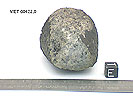
Macroscopic Description: Kathleen McBride
40% of the exterior of this meteorite is covered with a chocolate brown fusion crust. This crust is patchy and displays polygonal fractures. The exposed interior is gray and tan and has dark colored, crystalline clasts. The interior is mostly gray matrix with some areas of tan colored grains. This rock contains numerous euhedral clasts of various colors - black, green, white, yellow, and is moderately soft.
Thin Section (,2) Description: Tim McCoy and Linda Welzenbach
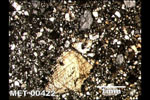 The section shows a groundmass of highly comminuted pyroxene, with the largest grain reaching 1.8 mm. Orthopyroxene has a composition of Fs22Wo1-2. The Fe/Mn ratio of the pyroxene is ~30. The meteorite is a diogenite.
The section shows a groundmass of highly comminuted pyroxene, with the largest grain reaching 1.8 mm. Orthopyroxene has a composition of Fs22Wo1-2. The Fe/Mn ratio of the pyroxene is ~30. The meteorite is a diogenite.
| Sample No.: | MET 00423 |
| Location: | Meteorite Hills |
| Field No.: | 13556 |
| Dimensions (cm): | 6.0x4.0x3.5 |
| Weight (g): | 79.375 |
| Meteorite Type: | Howardite |

Macroscopic Description: Kathleen McBride
~40% of the exterior surface is covered by dark brown fusion crust that has shiny, black patches. The surface contains "vugs" or areas where material has been plucked or weathered out. The fine-grained medium gray matrix has numerous euhedral clasts in various colors - gray, black, tan and white.
Thin Section (,2) Description: Tim McCoy and Linda Welzenbach
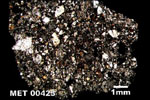 The section shows a groundmass of comminuted pyroxene and plagioclase (up to 1 mm) with medium- to coarse-grained basaltic clasts ranging up to 3 mm. Pyroxene includes orthopyroxene (Fs20-53Wo1-3) and exsolved pyroxenes of Fs49Wo5 to Fs22Wo38. The Fe/Mn ratio is ~30. Plagioclase is An78-93Or0-1. The meteorite is a howardite.
The section shows a groundmass of comminuted pyroxene and plagioclase (up to 1 mm) with medium- to coarse-grained basaltic clasts ranging up to 3 mm. Pyroxene includes orthopyroxene (Fs20-53Wo1-3) and exsolved pyroxenes of Fs49Wo5 to Fs22Wo38. The Fe/Mn ratio is ~30. Plagioclase is An78-93Or0-1. The meteorite is a howardite.
| Sample No.: | MET 00424 |
| Location: | Meteorite Hills |
| Field No.: | 13432 |
| Dimensions (cm): | 5.0x3.5x3.5 |
| Weight (g): | 98.873 |
| Meteorite Type: | Diogenite |

Macroscopic Description: Kathleen McBride
This achondrite's exterior has dull brown-black fusion crust over 90% of the surface. The fusion crust has a pearl like luster and exhibits polygonal fracturing. The interior is composed of crystalline mineral grains - white to light gray in color. Most of this material is now rust. Accessory minerals are black < 2 mm in diameter. Millimeter sized pale green and brown grains are also visible.
Thin Section (,2; ,6) Description: Tim McCoy and Linda Welzenbach
The meteorite exhibits a coarsely-brecciated structure, with clasts sizes of several mm. The individual clasts have mm-sized grains with irregular, intergrown grain boundaries. A single olivine grain was noted. Orthopyroxene is homogeneous (Fs27Wo1) and olivine is Fa29. A large (>5 mm) troilite nodule with a highly distorted polycrystalline texture is also present. The meteorite is a diogenite.
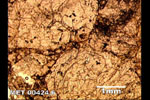
|

|
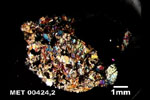
|
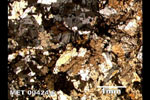
|
| Plane-Polarized Light | Reflected Light | Cross-Polarized Light | Cross-Polarized Light |
| Sample No.: | MET 00425 |
| Location: | Meteorite Hills |
| Field No.: | 13562 |
| Dimensions (cm): | 5.5x5.5x3.5 |
| Weight (g): | 118.302 |
| Meteorite Type: | Diogenite |
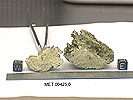
Thin Section (,2) Description: Tim McCoy and Linda Welzenbach
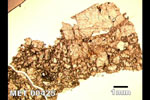
|
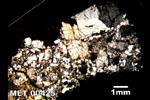
|
| Plane-Polarized Light | Cross-Polarized Light |
| Sample No.: | MET 00426 |
| Location: | Meteorite Hills |
| Field No.: | 13708 |
| Dimensions (cm): | 3.5x3.0x2.0 |
| Weight (g): | 31.326 |
| Meteorite Type: | CR2 Chondrite |

Thin Section (,2) Description: Tim McCoy and Linda Welzenbach

|

|
| Plane-Polarized Light | Cross-Polarized Light |
| Sample No.: | MET 00427 |
| Location: | Meteorite Hills |
| Field No.: | 13749 |
| Dimensions (cm): | 3.5x2.5x2.0 |
| Weight (g): | 18.558 |
| Meteorite Type: | Howardite |

Thin Section (,2) Description: Tim McCoy and Linda Welzenbach
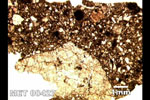
|
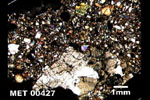
|
| Plane-Polarized Light | Cross-Polarized Light |
| Sample No.: | MET 00428 |
| Location: | Meteorite Hills |
| Field No.: | 13040 |
| Dimensions (cm): | 3.5x2.5x1.5 |
| Weight (g): | 45.774 |
| Meteorite Type: | Iron-Ungrouped |

Macroscopic Description: Kathleen McBride and Tim McCoy
This 45.8 g ellipsoidal specimen has a frothy exterior. One end of the specimen exhibits a rounded depression. The end of the mass appears as if it may have been torn from another piece during atmospheric passage.
Microscopic Description: Tim McCoy
The section is dominated by Fe, Ni metal with 10-20 vol.% of rounded, elongate and ellipsoidal troilite inclusions that range in size from 200 microns to 2 mm in maximum dimension, with most less than 1 mm. The section is bounded by an a2 structure produced during atmospheric heating that extends up to 2 mm into the interior of the meteorite. Rare fusion crust is present. The frothy exterior resulted from a combination of atmospheric ablation and terrestrial weathering of the troilite inclusions. The troilite inclusions exhibit multiple twinning from deformation. No silicate or chromite inclusions were observed. Swathing kamacite surrounds the troilite inclusions. In areas of relatively few troilite inclusions, a weak Widmanstatten pattern is observed, with very thin kamacite lamellae (100-120 microns wide). Kamacite exhibits numerous Neumann bands and these bands are subsequently bent or, in many cases, sheared by subsequent microfaults. Large areas between kamacite bands are dominated by net or finger plessite. The classification of this meteorite is uncertain. Most other troilite-rich meteorites (e.g., Mundrabilla, LEW 86211, Soroti) differ significantly. The closest relative may be the fine octahedrite Mont Dieu, which is a member of group IIE.
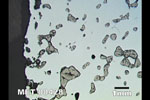
|
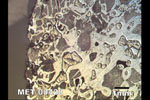
|
|
| Ref. Light - Polished Sur. | Ref. Light - Etched Surface |
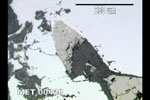
|
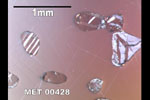
|
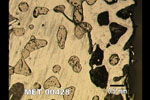
|
| Reflected Light - Melted Troilite | Reflected Light - Troilite | Reflected Light - Etched Surface |
| Sample No.: | MET 00431; 00433; 00434; 00435 |
| Location: | Meteorite Hills |
| Field No.: | 13569; 13755; 13765; 13791 |
| Dimensions (cm): | 4.5x3.5x1.0; 2.5x3.5x1.0; 3.0x2.0x1.0; 2.0x1.5x0.5 |
| Weight (g): | 23.368; 10.897; 6.125; 2.385 |
| Meteorite Type: | CM2 Chondrite |

Macroscopic Description: Kathleen McBride
The exterior of these meteorites is black. The interior is platy and black in color with evaporites and tiny, round, white chondrules.
Thin Section (,2) Descriptions: Tim McCoy and Linda Welzenbach

|
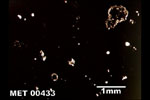
|
| MET 00431 Cross-Pol. Light | MET 00433 Cross-Pol. Light |
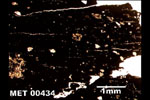
|
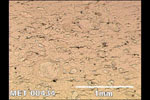
|
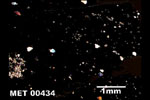
|
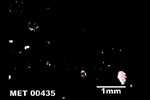
|
| MET 00434 Plane-Pol. Light | MET 00434 Reflected Light | MET 00434 Cross-Pol. Light | MET 00435 Cross-Pol. Light |
| Sample No.: | MET 00432 |
| Location: | Meteorite Hills |
| Field No.: | 13407 |
| Dimensions (cm): | 4.5x3.5x3.0 |
| Weight (g): | 38.900 |
| Meteorite Type: | CM2 Chondrite |

Thin Section (,2) Description: Tim McCoy and Linda Welzenbach

|

|
| Plane-Polarized Light | Cross-Polarized Light |
| Sample No.: | MET 00436 |
| Location: | Meteorite Hills |
| Field No.: | 12247 |
| Dimensions (cm): | 14.0x7.5x10 |
| Weight (g): | 1765.600 |
| Meteorite Type: | Diogenite |
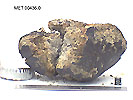
Thin Section (,2) Description: Tim McCoy and Linda Welzenbach
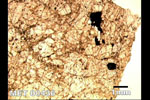
|
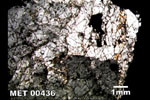
|
| Plane-Polarized Light | Cross-Polarized Light |